Choosing a Gaming CPU at 1440p: Adding in Haswell
by Ian Cutress on June 4, 2013 10:00 AM ESTCPU Benchmarks
Point Calculations - 3D Movement Algorithm Test
The algorithms in 3DPM employ both uniform random number generation or normal distribution random number generation, and vary in amounts of trigonometric operations, conditional statements, generation and rejection, fused operations, etc. The benchmark runs through six algorithms for a specified number of particles and steps, and calculates the speed of each algorithm, then sums them all for a final score. This is an example of a real world situation that a computational scientist may find themselves in, rather than a pure synthetic benchmark. The benchmark is also parallel between particles simulated, and we test the single threaded performance as well as the multi-threaded performance.
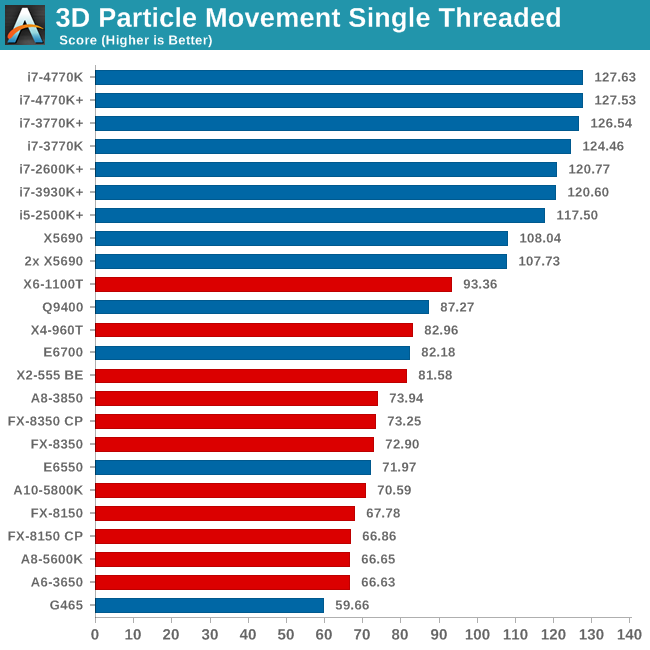
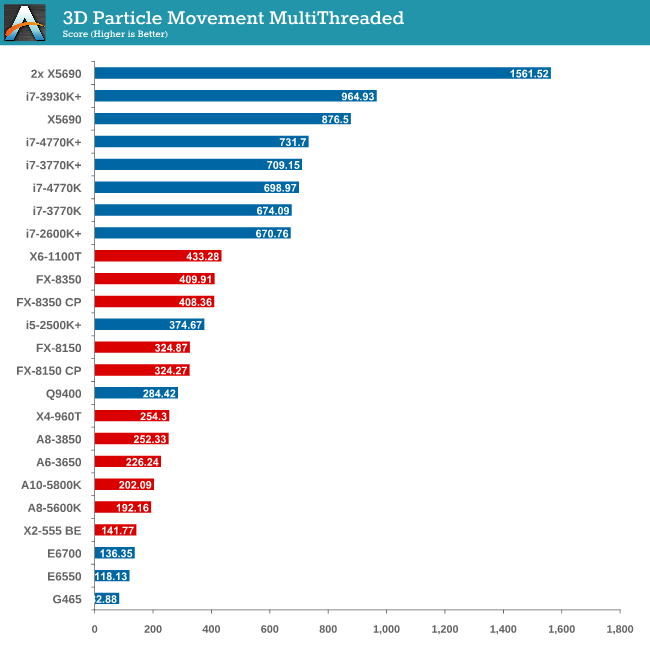
As mentioned in previous reviews, this benchmark is written how most people would tackle the situation – using floating point numbers. This is also where Intel excels, compared to AMD’s decision to move more towards INT ops (such as hashing), which is typically linked to optimized code or normal OS behavior.
The 4770K comes in top in single threaded performance, showcasing the IPC gains of the new architecture. This is also shown in multithreaded tests with MCT both off and on.
Compression - WinRAR x64 3.93 + WinRAR 4.2
With 64-bit WinRAR, we compress the set of files used in our motherboard USB speed tests. WinRAR x64 3.93 attempts to use multithreading when possible and provides a good test for when a system has variable threaded load. WinRAR 4.2 does this a lot better! If a system has multiple speeds to invoke at different loading, the switching between those speeds will determine how well the system will do.
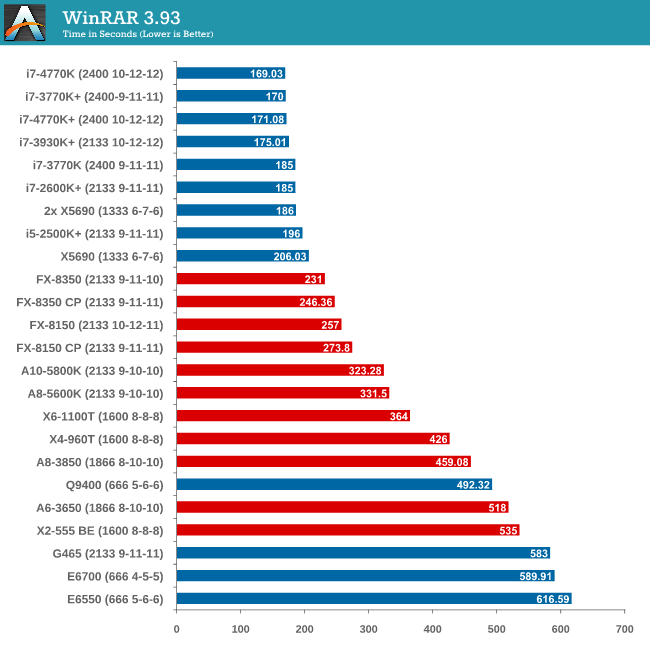
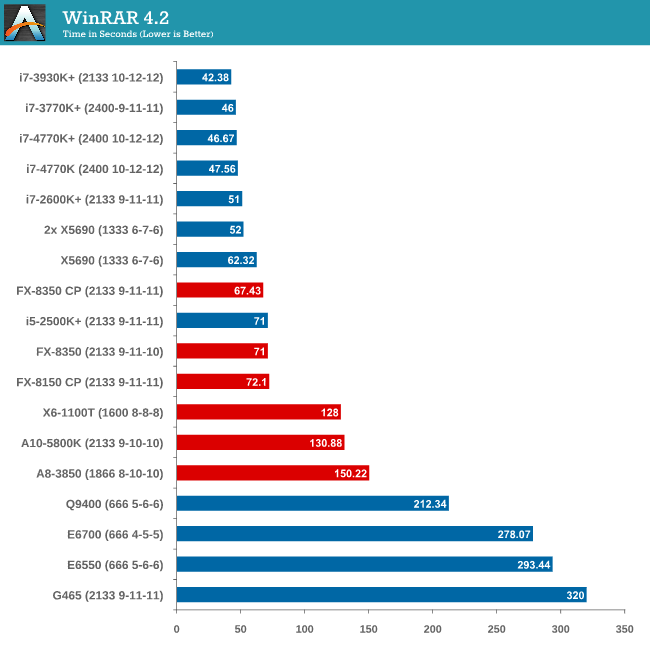
Due to the late inclusion of 4.2, our results list for it is a little smaller than I would have hoped. But it is interesting to note that with the Core Parking updates, an FX-8350 overtakes an i5-2500K with MCT.
Image Manipulation - FastStone Image Viewer 4.2
FastStone Image Viewer is a free piece of software I have been using for quite a few years now. It allows quick viewing of flat images, as well as resizing, changing color depth, adding simple text or simple filters. It also has a bulk image conversion tool, which we use here. The software currently operates only in single-thread mode, which should change in later versions of the software. For this test, we convert a series of 170 files, of various resolutions, dimensions and types (of a total size of 163MB), all to the .gif format of 640x480 dimensions.
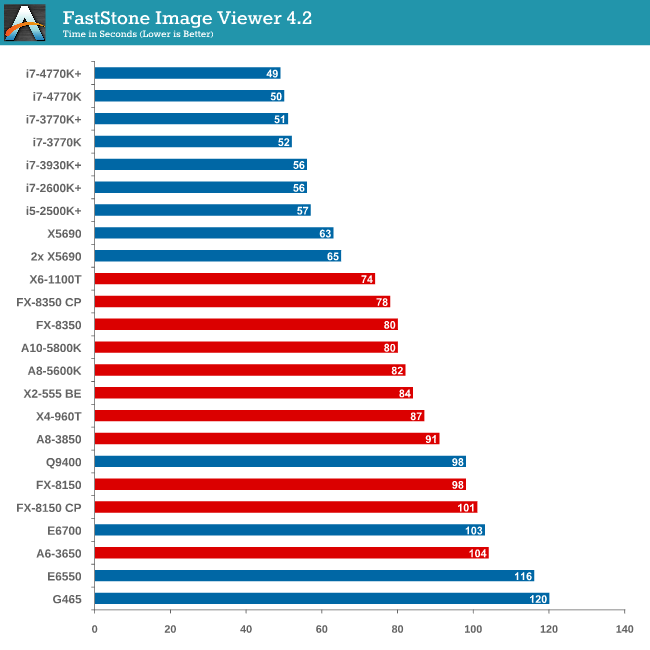
In terms of pure single thread speed, it is worth noting the X6-1100T is leading the AMD pack, and the 4770K takes the top spot. .
Video Conversion - Xilisoft Video Converter 7
With XVC, users can convert any type of normal video to any compatible format for smartphones, tablets and other devices. By default, it uses all available threads on the system, and in the presence of appropriate graphics cards, can utilize CUDA for NVIDIA GPUs as well as AMD WinAPP for AMD GPUs. For this test, we use a set of 33 HD videos, each lasting 30 seconds, and convert them from 1080p to an iPod H.264 video format using just the CPU. The time taken to convert these videos gives us our result.
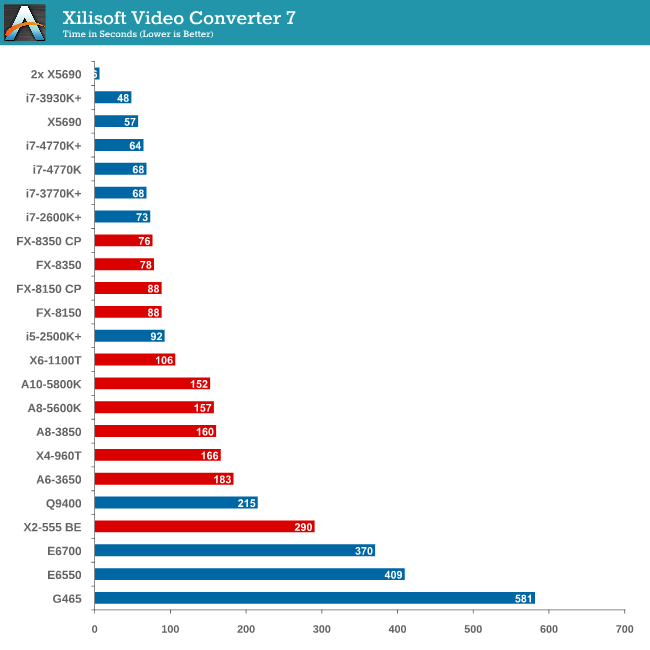
XVC is a little odd in how it arranges its multicore processing. For our set of 33 videos, it will arrange them in batches of threads – so if we take the 8 thread FX-8350, it will arrange the videos into 4 batches of 8, and then a fifth batch of one. That final batch will only have one thread assigned to it (!), and will not get a full 8 threads worth of power. This is also why the 2x X5690 finishes in 6 seconds but the normal X5690 takes longer – you would expect a halving of time moving to two CPUs but XVC arranges the batches such that there is always one at the end that only gets a single thread.
Rendering – PovRay 3.7
The Persistence of Vision RayTracer, or PovRay, is a freeware package for as the name suggests, ray tracing. It is a pure renderer, rather than modeling software, but the latest beta version contains a handy benchmark for stressing all processing threads on a platform. We have been using this test in motherboard reviews to test memory stability at various CPU speeds to good effect – if it passes the test, the IMC in the CPU is stable for a given CPU speed. As a CPU test, it runs for approximately 2-3 minutes on high end platforms.
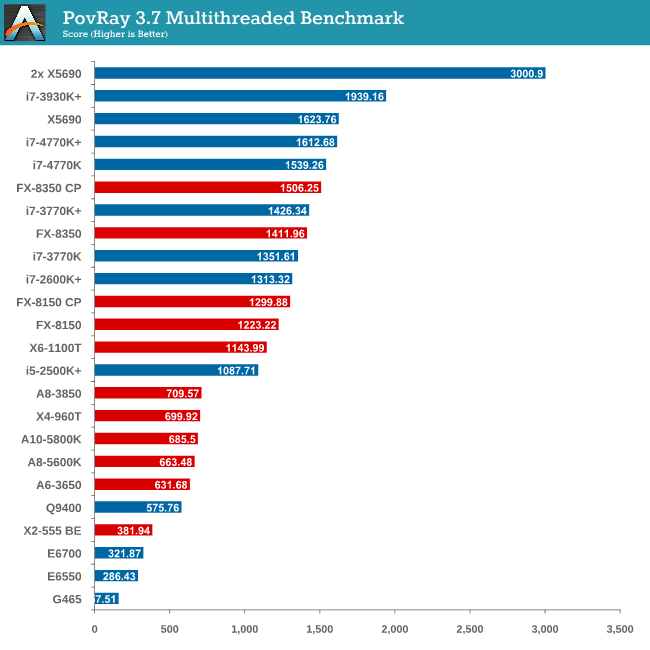
The SMP engine in PovRay is not perfect, though scaling up in CPUs gives almost a 2x effect. The results from this test are great – here we see an FX-8350 CPU below an i7-3770K (with MCT), until the Core Parking updates are applied, meaning the FX-8350 performs better! The 4770K also has a chance to flex its compute muscles, performing almost as well as the 8-core Westmere CPU.
Video Conversion - x264 HD Benchmark
The x264 HD Benchmark uses a common HD encoding tool to process an HD MPEG2 source at 1280x720 at 3963 Kbps. This test represents a standardized result which can be compared across other reviews, and is dependent on both CPU power and memory speed. The benchmark performs a 2-pass encode, and the results shown are the average of each pass performed four times.
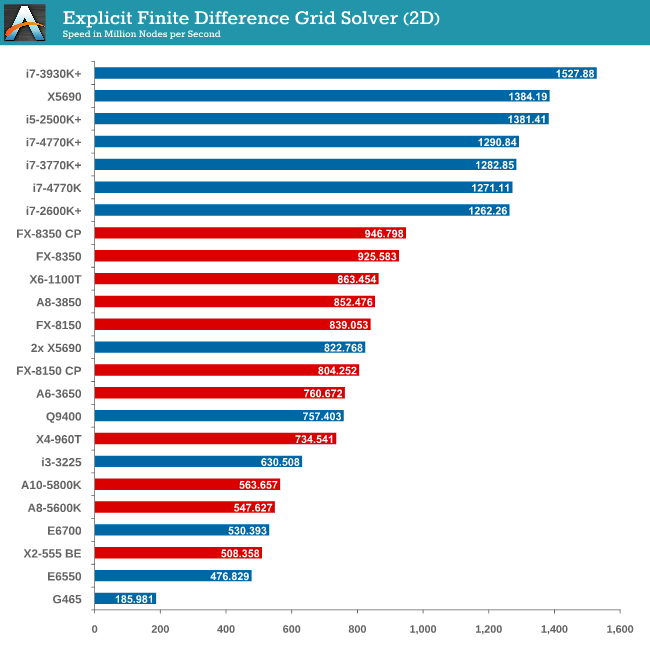
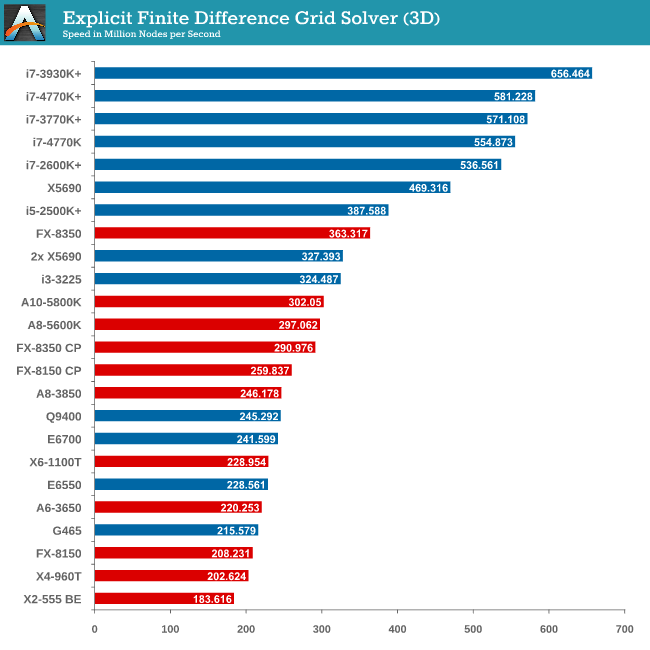
Grid Solvers - Explicit Finite Difference
For any grid of regular nodes, the simplest way to calculate the next time step is to use the values of those around it. This makes for easy mathematics and parallel simulation, as each node calculated is only dependent on the previous time step, not the nodes around it on the current calculated time step. By choosing a regular grid, we reduce the levels of memory access required for irregular grids. We test both 2D and 3D explicit finite difference simulations with 2n nodes in each dimension, using OpenMP as the threading operator in single precision. The grid is isotropic and the boundary conditions are sinks. Values are floating point, with memory cache sizes and speeds playing a part in the overall score.
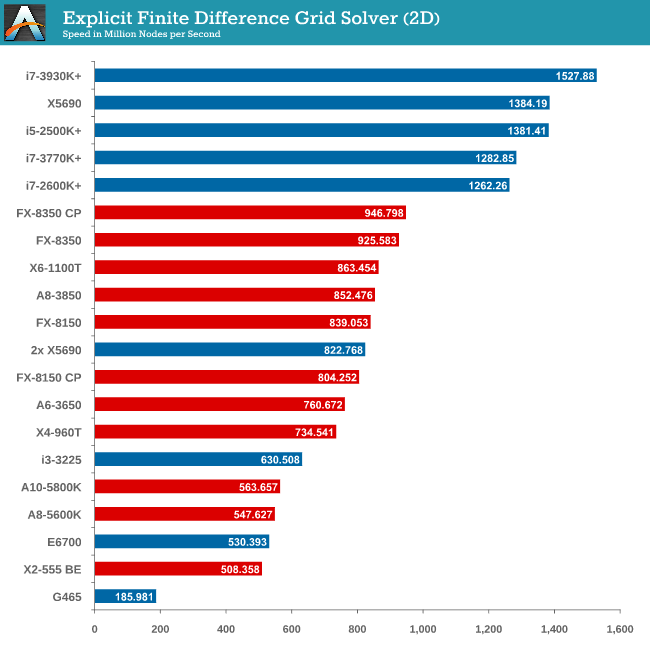
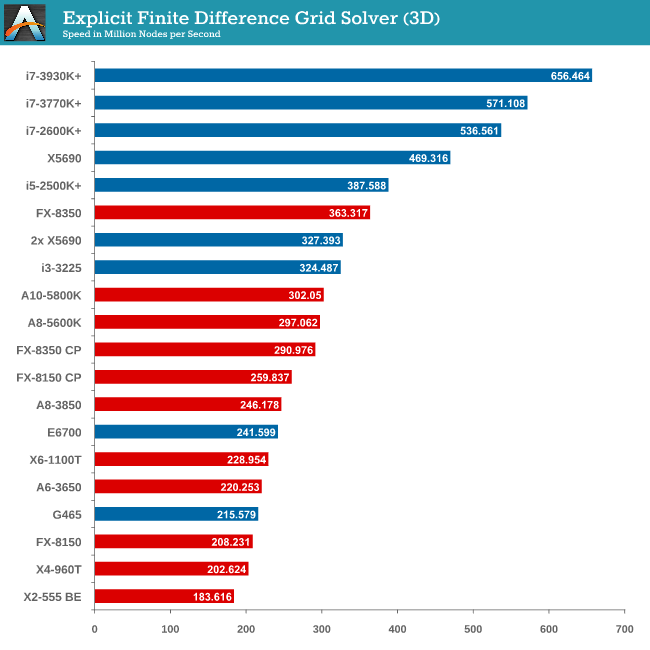
Grid solvers do love a fast processor and plenty of cache in order to store data. When moving up to 3D, it is harder to keep that data within the CPU and spending extra time coding in batches can help throughput. Our simulation takes a very naïve approach in code, using simple operations.
Grid Solvers - Implicit Finite Difference + Alternating Direction Implicit Method
The implicit method takes a different approach to the explicit method – instead of considering one unknown in the new time step to be calculated from known elements in the previous time step, we consider that an old point can influence several new points by way of simultaneous equations. This adds to the complexity of the simulation – the grid of nodes is solved as a series of rows and columns rather than points, reducing the parallel nature of the simulation by a dimension and drastically increasing the memory requirements of each thread. The upside, as noted above, is the less stringent stability rules related to time steps and grid spacing. For this we simulate a 2D grid of 2n nodes in each dimension, using OpenMP in single precision. Again our grid is isotropic with the boundaries acting as sinks. Values are floating point, with memory cache sizes and speeds playing a part in the overall score.
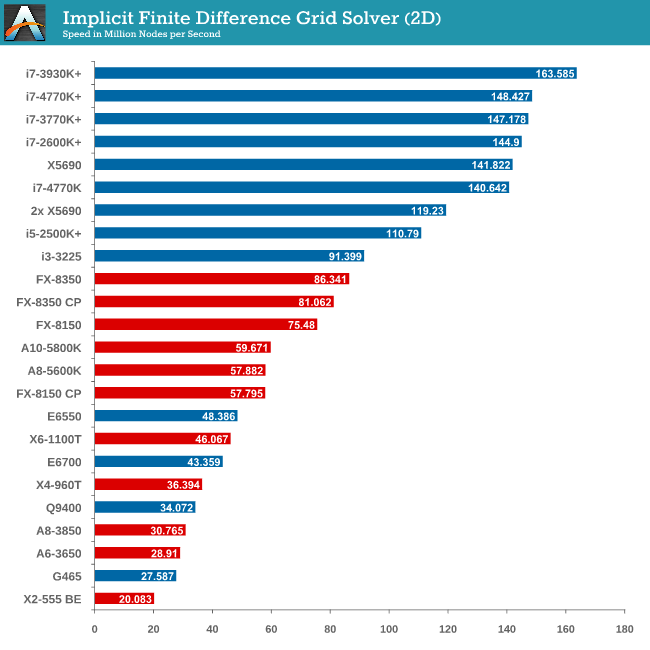
2D Implicit is harsher than an Explicit calculation – each thread needs more a lot memory, which only ever grows as the size of the simulation increases.
Point Calculations - n-Body Simulation
When a series of heavy mass elements are in space, they interact with each other through the force of gravity. Thus when a star cluster forms, the interaction of every large mass with every other large mass defines the speed at which these elements approach each other. When dealing with millions and billions of stars on such a large scale, the movement of each of these stars can be simulated through the physical theorems that describe the interactions. The benchmark detects whether the processor is SSE2 or SSE4 capable, and implements the relative code. We run a simulation of 10240 particles of equal mass - the output for this code is in terms of GFLOPs, and the result recorded was the peak GFLOPs value.
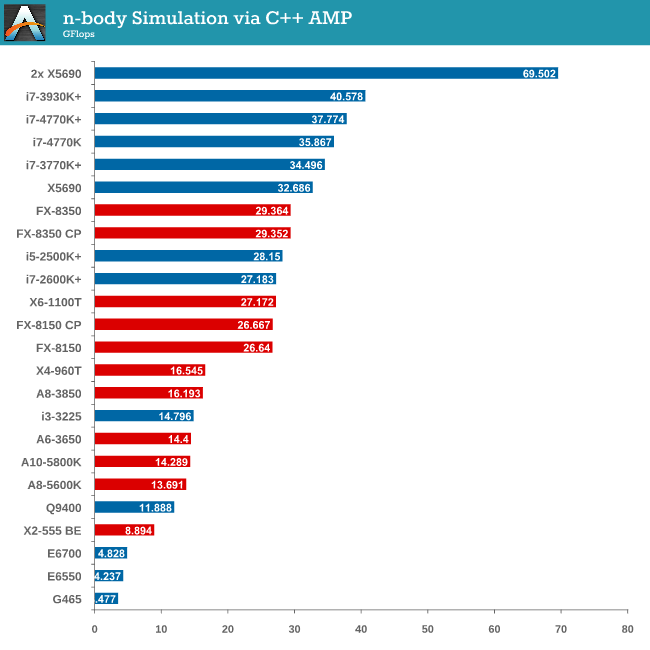
As we only look at base/SSE2/SSE4 depending on the processor (auto-detection), we don’t see full AVX numbers in terms of FLOPs.










116 Comments
View All Comments
gonks - Tuesday, June 4, 2013 - link
Great work Ian! Definitely waiting to see i5-3570K added into the mix, to see how it compares to the i5-2500k (and the 3570k beeing more futureproof thanks to PCIe 3.0).Harby - Tuesday, June 4, 2013 - link
Excellent review, though it would be awesome to see World of Warcraft and Rift in there. Both are heavily relying on CPU.yougotkicked - Tuesday, June 4, 2013 - link
As always, thanks for the great article and hard work Ian.I'd really like to see how a few of the tests scale with overclocked CPU's, notably those in which the sandy bridge processors were competitive with ivy bridge and haswell parts. Obviously overclocking introduces a lot of variables into your testing, but it would be very interesting to see a few of the popular choices tested (sandy bridge parts @ 4.5 are quite common, and many users on such a system were waiting for haswell before they upgrade).
eBombzor - Tuesday, June 4, 2013 - link
Crysis 3 benchmarks PLEASE!!frozentundra123456 - Tuesday, June 4, 2013 - link
Interesting results, but very limited as well. Why test at a resolution used by only 4% of the players?I would have rather seen the results at 1080p, over a wider variety of games. Especially RTS games and newer games like crysis 3, FC3, and Tomb Raider. I tested Heart of the Swarm on my computer with a HD7770 and i5 2320 and was able to max out the cpu in a 10 player skirmish match at ultra, 1080p. So I am sure an A8-5600 would be limiting in that case.
Even considering the results only of the games tested, the A8-5600k seems a strange choice. The i3 seems just as valid, considering it is equal or faster in every game but one, while using less power.
makerofthegames - Tuesday, June 4, 2013 - link
Question - are those blank entries for the Xeons because they could not run, or just that data was not collected for them?Awful - Tuesday, June 4, 2013 - link
Glad to see there's no reason to upgrade the i5-2500k in my desktop yet - still happily chugging away at 4.9GHz after 2 years!holistic - Tuesday, June 4, 2013 - link
Ian,Thank you, for your time, effort, and energy in compiling an encyclopedic database on the effects of cpu on single and multi gpu configurations, in alternate gaming/engine scenarios. Your work is insightful, informative, and wholly devoted to the science of benchmarking. This approach has helped me, as a relatively new computer enthusiast, to more deeply understand testing methodology in the computing field.
I am interested in the pure CPU benchmarks of Starcraft 2 with the 4770k and 4670k. I understand this game is not optimized, is directx9, and is extremely cpu limited with only 2 maximum cores active, and thus not in top priority for providing benchmarks. Will haswell be added to the benchmarking database for sc2?
Cheers,
Craig
khanov - Tuesday, June 4, 2013 - link
Ian, I have to say (again) that i7-3820 should be in this review.You say that i7-4770K is a better value proposition than Sandy Bridge-E (X79), I assume because you are only thinking of the expensive 6 core X79 CPU's. That changes if you do consider i7-3820.
X79 brings far better support for multi-gpu setups with enough PCIe lanes to feed multiple cards quite happily. No PLX needed. Pair that with an i7 3820 (cheaper than i7-3770K/i7-4770K) and you may find the performance surprisingly good for the price.
chizow - Friday, June 7, 2013 - link
I considered the 3820 numerous times (it's cheap at MC, same price as high-end 3770K/4770K) but I shy away because it inexplicably performs *WORST* than 2700K/3770K/4770K. I don't know why, it has more L3 cache, and is clocked higher before/after boost. Just an oddball chip.Besides, X79 as a platform was dated almost as soon as it released. PCIe 3.0 support is spotty with Nvidia (reg hack not guaranteed), no native USB 3.0 and no full SATA 6G support. I went for Z87 + 4770K instead because X79 + 3820 didn't offer any noticeable advantages while carrying a significant higher price tag (board price).